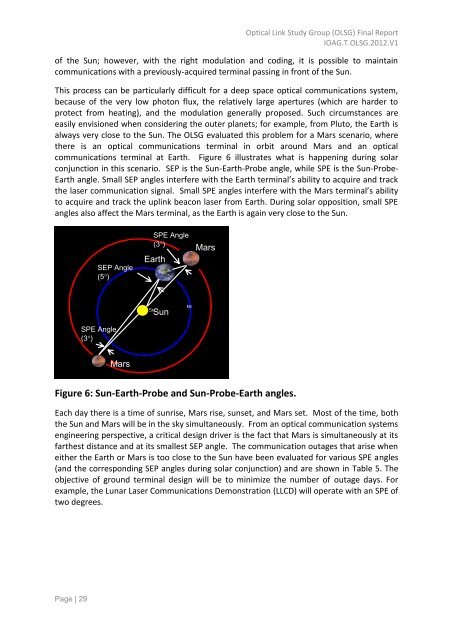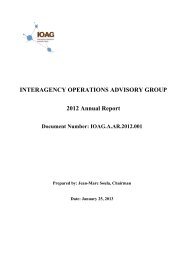OLSG Report_Final_06_05_12 - Interagency Operations Advisory ...
OLSG Report_Final_06_05_12 - Interagency Operations Advisory ...
OLSG Report_Final_06_05_12 - Interagency Operations Advisory ...
Create successful ePaper yourself
Turn your PDF publications into a flip-book with our unique Google optimized e-Paper software.
Optical Link Study Group (<strong>OLSG</strong>) <strong>Final</strong> <strong>Report</strong><br />
IOAG.T.<strong>OLSG</strong>.20<strong>12</strong>.V1<br />
of the Sun; however, with the right modulation and coding, it is possible to maintain<br />
communications with a previously-acquired terminal passing in front of the Sun.<br />
This process can be particularly difficult for a deep space optical communications system,<br />
because of the very low photon flux, the relatively large apertures (which are harder to<br />
protect from heating), and the modulation generally proposed. Such circumstances are<br />
easily envisioned when considering the outer planets; for example, from Pluto, the Earth is<br />
always very close to the Sun. The <strong>OLSG</strong> evaluated this problem for a Mars scenario, where<br />
there is an optical communications terminal in orbit around Mars and an optical<br />
communications terminal at Earth. Figure 6 illustrates what is happening during solar<br />
conjunction in this scenario. SEP is the Sun-Earth-Probe angle, while SPE is the Sun-Probe-<br />
Earth angle. Small SEP angles interfere with the Earth terminal’s ability to acquire and track<br />
the laser communication signal. Small SPE angles interfere with the Mars terminal’s ability<br />
to acquire and track the uplink beacon laser from Earth. During solar opposition, small SPE<br />
angles also affect the Mars terminal, as the Earth is again very close to the Sun.<br />
SPE Angle<br />
(3)<br />
SEP Angle<br />
(5)<br />
SPE Angle<br />
(3)<br />
Figure 6: Sun-Earth-Probe and Sun-Probe-Earth angles.<br />
Each day there is a time of sunrise, Mars rise, sunset, and Mars set. Most of the time, both<br />
the Sun and Mars will be in the sky simultaneously. From an optical communication systems<br />
engineering perspective, a critical design driver is the fact that Mars is simultaneously at its<br />
farthest distance and at its smallest SEP angle. The communication outages that arise when<br />
either the Earth or Mars is too close to the Sun have been evaluated for various SPE angles<br />
(and the corresponding SEP angles during solar conjunction) and are shown in Table 5. The<br />
objective of ground terminal design will be to minimize the number of outage days. For<br />
example, the Lunar Laser Communications Demonstration (LLCD) will operate with an SPE of<br />
two degrees.<br />
Page | 29



